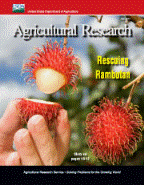United States Department of Agriculture: Agricultural Research Service, Lincoln, Nebraska

Agricultural Research Magazine
Date of this Version
7-2013
Document Type
Article
Citation
Agricultural Research July 2013.
Abstract
Simple, swift, and comparatively inexpensive, a color-image-based seed sorter is helping plant breeders and others separate the seeds they want from those they don’t—with an impressive degree of accuracy.
Agricultural Research Service agricultural engineer Thomas C. Pearson, based at the agency’s Center for Grain and Animal Health Research in Manhattan, Kansas, developed the sorter in collaboration with National Manufacturing in Lincoln, Nebraska. The company has marketed the device to customers in the United States and abroad since 2010.
In tests, the compact, portable sorter— a simpler and faster version of other machine-vision equipment that Pearson developed in 2009—speedily differentiated kernels of hard red wheat from kernels of hard white winter wheat with 98.6 percent accuracy. Says Pearson, “Breeders cross red and white varieties of these bread-making wheats to transfer desirable traits from one to another. Test fields are planted with both hard red and hard white wheat. At harvest, the seeds have to be separated.”
The sorter is also skilled at separating yellow from brown flax and barley from durum wheat.
Pearson explains that yellow flax is used somewhat like sesame seeds as a tasty, nut-flavored garnish for breads and other baked goods, while brown flax is harvested for its oil. The sorter was accurate 94 percent of the time in detecting yellow flax seeds from brown ones in Pearson’s tests.
Barley plants can sometimes turn up as unwanted “rogues” or “volunteers” in neighboring test rows of candidate durum wheats. The sorter system detected durum kernels with 93 percent accuracy, Pearson reports.
Included in
Agriculture Commons, Animal Sciences Commons, Food Science Commons, Plant Sciences Commons

